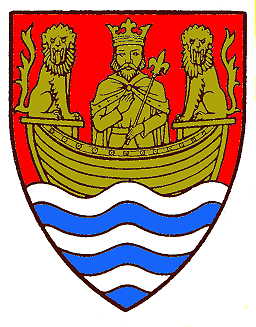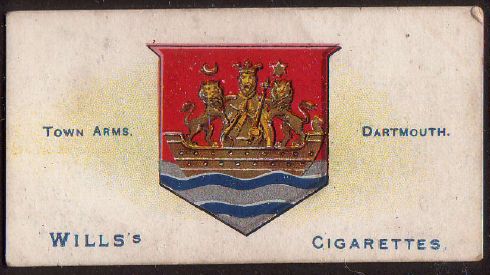Dartmouth: Difference between revisions
Knorrepoes (talk | contribs) m (Text replacement - "====Official blazon====" to "===Official blazon===") |
Knorrepoes (talk | contribs) m (Text replacement - "====Origin/meaning====" to "===Origin/meaning===") |
||
| Line 10: | Line 10: | ||
Gules on Water barry wavy in base proper an Ancient Ship issuant from the centre thereof the Figure of a King robed crowned and holding in his sinister hand a Sceptre on the bow and on the stern of the ship a Lion sejant guardant that to the dexter contourné all Or. | Gules on Water barry wavy in base proper an Ancient Ship issuant from the centre thereof the Figure of a King robed crowned and holding in his sinister hand a Sceptre on the bow and on the stern of the ship a Lion sejant guardant that to the dexter contourné all Or. | ||
===Origin/meaning=== | |||
The arms were historically recorded as a seal device (untinctured) at the Visitation of 1620; confirmed by Kings' of Arms Certificate 31st January 1951. | The arms were historically recorded as a seal device (untinctured) at the Visitation of 1620; confirmed by Kings' of Arms Certificate 31st January 1951. | ||
Revision as of 19:09, 22 June 2017
| Heraldry of the World |
| British heraldry portal Civic heraldry of the United Kingdom |
|
DARTMOUTH
Incorporated into : 1974 South Hams
Official blazon
Gules on Water barry wavy in base proper an Ancient Ship issuant from the centre thereof the Figure of a King robed crowned and holding in his sinister hand a Sceptre on the bow and on the stern of the ship a Lion sejant guardant that to the dexter contourné all Or.
Origin/meaning
The arms were historically recorded as a seal device (untinctured) at the Visitation of 1620; confirmed by Kings' of Arms Certificate 31st January 1951.
The arms are based on an ancient seal of the former Corporation. The figure is believed to be Edward III, who granted the town a charter.The arms bear a general resemblance to his gold noble, in which he is represented as 'Lord of the Sea'; and the are a reminder that Darmouth provided ships for his French wars. On the seal and in some representations of the arms, a crescent and star are placed either side of the king's head. These were originally crusading emblems, and are thought to refer to the fact that Richard I's host sailed from Dartmouth for the Holy Land.
| The arms on a Wills's cigarette card, 1906 |
Contact and Support
Partners:
Your logo here ?
Contact us
© since 1995, Heraldry of the World, Ralf Hartemink 
Index of the site
Literature : Image and information from here













